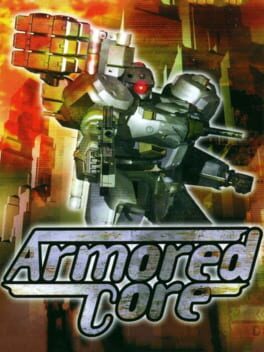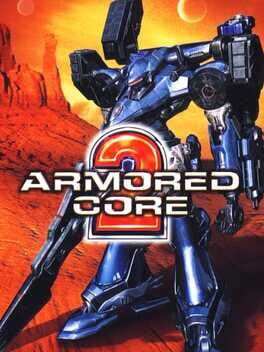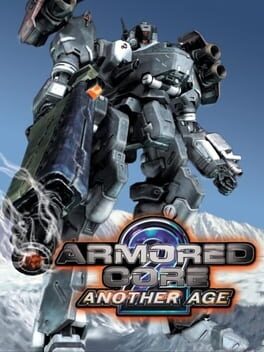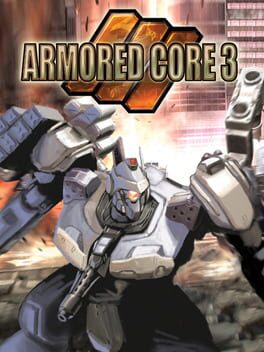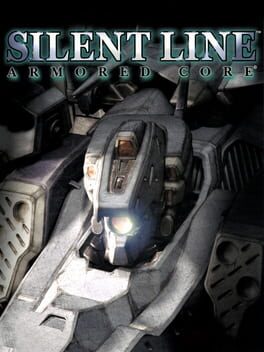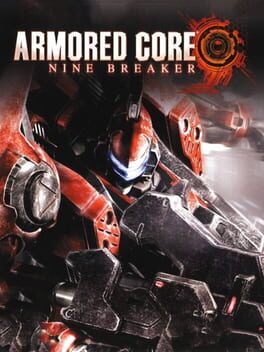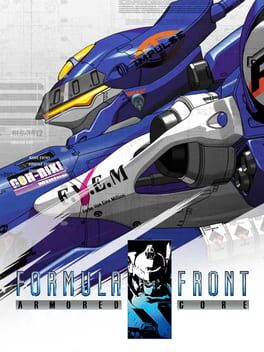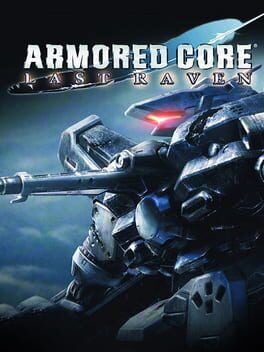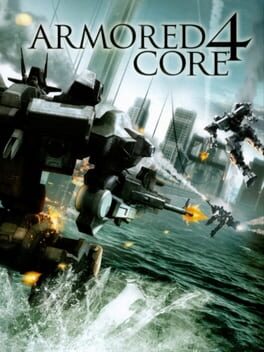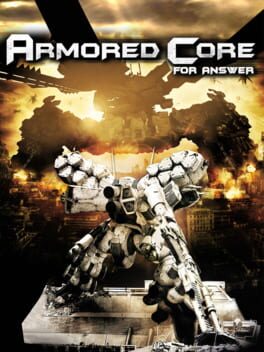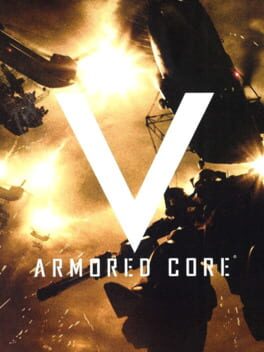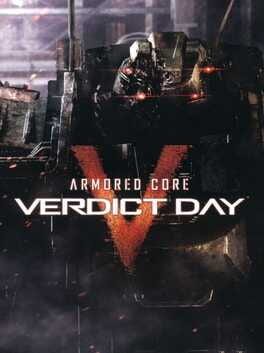What's Special About Every Armored Core
For a series with a reputation for being very similar across entries, I actually think that each Armored Core game applies its gradual iterations to provide a unique flavor all its own. They're all very good and many of them do at least one thing better than any other entry in the franchise. So rather than ranking or reviewing them, I wanted to just take some time to highlight at least one unique X-Factor that sticks out to me about every game in the series from AC1 to ACVI. Enjoy!
By the way, since I know reading blurbs on Backloggd lists can be a bit finicky, I also published this as a piece on medium if you'd rather read there!
By the way, since I know reading blurbs on Backloggd lists can be a bit finicky, I also published this as a piece on medium if you'd rather read there!
16 Games
Being the first entry in the series, plenty of things could be singled out as a special element that AC1 brings to the table, such as the music, the wonderful visual aesthetic, or the oppressive atmosphere. Maybe it’s the establishment of a combat speed so fast that it wouldn't come close to being matched until AC4, or the mischievous mission design, or the emphasis on customization. Perhaps it’s the game’s flirtations with a branching structure that culminates in one of two moody endings, a rarity in the series!
For me, the thing I really want to single out as being special about the original game is its systemic storytelling. The monetary system makes it easy to complete an assignment only to find that the cost of operating and repairing your AC eclipses the pay received, leaving you in the red and creating a spiral of debt. Attached to that debt mechanic is the unique fail state, in which incurring too much debt forces the player to pay it off by donating their body to corporate science and restarting the game (with new superhuman abilities to make things a little easier this time). These elements plant the player firmly in Armored Core's hypercapitalist, gig-economy dystopia of warring corporations and mercenaries scraping by, loyal only to the highest bidder. Plenty of other AC games share this general premise, but perhaps no other game in the series executes on it so cleanly and intensely through gameplay systems.
If you're looking to play some Armored Core and you don't know which one to play, you can seriously just boot this game up and start at the beginning. It's a true classic.
For me, the thing I really want to single out as being special about the original game is its systemic storytelling. The monetary system makes it easy to complete an assignment only to find that the cost of operating and repairing your AC eclipses the pay received, leaving you in the red and creating a spiral of debt. Attached to that debt mechanic is the unique fail state, in which incurring too much debt forces the player to pay it off by donating their body to corporate science and restarting the game (with new superhuman abilities to make things a little easier this time). These elements plant the player firmly in Armored Core's hypercapitalist, gig-economy dystopia of warring corporations and mercenaries scraping by, loyal only to the highest bidder. Plenty of other AC games share this general premise, but perhaps no other game in the series executes on it so cleanly and intensely through gameplay systems.
If you're looking to play some Armored Core and you don't know which one to play, you can seriously just boot this game up and start at the beginning. It's a true classic.
Project Phantasma takes the foundation from AC1 and turns it into a leaner, meaner, more refined experience. The mission design is among the most sophisticated in the entire series, with each mission featuring a unique, layered scenario or problem to solve, often lining up two or three of them in a row within a single mission. Every one of them is distinct and memorable, making this the Armored Core game that feels the most to me like a great album. Those longer, more complex missions are paired with a more character-driven story, with a recurring antagonist and deuteragonist adding a particular narrative bite that these games rarely went after again. One of the very best in the series.
The game takes an interesting approach to the arena battles featured in the previous game by tying them directly into the core game progression, but the real X-Factor to me is another feature tied into the overall game structure: the antagonist.
Master of Arena is all about the impending showdown between the player and the most terrifying enemy from AC1. Every element goes to intensifying that showdown and creating a final level that's a high point for the franchise. Where Project Phantasma dabbled with creating a more character-driven Armored Core, Master of Arena fuses the motivations of player and player-character, driving the entire first generation of AC games into a single sharp point, culminating in a climactic battle against the ultimate nemesis.
Master of Arena is all about the impending showdown between the player and the most terrifying enemy from AC1. Every element goes to intensifying that showdown and creating a final level that's a high point for the franchise. Where Project Phantasma dabbled with creating a more character-driven Armored Core, Master of Arena fuses the motivations of player and player-character, driving the entire first generation of AC games into a single sharp point, culminating in a climactic battle against the ultimate nemesis.
The only game in the series to take place off of Earth (until ACVI), AC2 sports a vibe really unique to itself. The Mars colony scenario plays well into the cutthroat world of corps and mercs, and Leos Klein makes for an intriguing villain.
For some the game's greatly expanded parts library from the first generation and new mechanics may get the nod, but my personal favorite thing about AC2 is just the overall game scenario. It has an urgent, alien atmosphere and a fun villain whose actions greatly impact both individual missions and the overall plot, and when it's time to head up into space to deal with him, there's nothing else exactly like it in Armored Core.
For some the game's greatly expanded parts library from the first generation and new mechanics may get the nod, but my personal favorite thing about AC2 is just the overall game scenario. It has an urgent, alien atmosphere and a fun villain whose actions greatly impact both individual missions and the overall plot, and when it's time to head up into space to deal with him, there's nothing else exactly like it in Armored Core.
The biggest AC game in terms of mission count, this thing is just solid gameplay all the way down. Outside of a slim framing narrative, Another Age is freed of any narrative obligations (even more so than other games in the franchise), and gets to just be a gigantic mission pack using the mechanics of AC2. The large number of missions, with plenty of variety in their design and terrain, makes this one highly rewarding to players who like building a whole stable of very different ACs to deal with different challenges. It lets customization shine, so for lovers of that aspect of these and other games, Another Age is an entry in the series not to be missed.
Armored Core 3 is the series itself, refined and defined. Movement, especially during combat, is simultaneously faster and more fluid than AC2, and less erratic and finicky than AC1. The very good mission design is bolstered by the new Consort system that allows players to hire allies on missions. Being the first reboot of the series’ continuity, AC3 borrows classic scenario details, worldbuilding, and narrative beats from AC1, much to its benefit. End to end, AC3 trims, embellishes, and remixes elements from its forebears to make the ideal version of itself. It may not be my personal favorite Armored Core, but there’s a good case to be made that it is the definitive Armored Core, presenting the series in perhaps its cleanest, most elegant light.
If AC3 nailed the essential Armored Core formula, what’s special about Silent Line is the utter sense of confidence and energy in going even further beyond. A massively expanded parts list makes this game a customizer’s dream, and the mission design is operating at the peak of classic Armored Core’s potential. Each mission has multiple secret parts to find, rewarding thorough exploration like the series hadn’t previously seen. Missions not only feature enjoyable and rewarding initial objectives, they present midpoint complications that flip battles on their head, and optional followup chapters that give them an incredibly satisfying depth. They even have a subtle dynamism that a player is unlikely to detect on a first playthrough, altering mission events and encounters based on player performance. It takes what was already a winning gameplay framework and carries it even further into the ranks of elite action games.
Silent Line deserves praise for many little things, though one X-Factor element I’d never dare to neglect mentioning is the soundtrack. Previous games are full of great tracks without a doubt, but for my money the strikingly different direction the music of this game takes is incredible. Many of the songs are moody, melancholy, beautiful, haunting, eerie, and worth the price of admission alone.
Silent Line deserves praise for many little things, though one X-Factor element I’d never dare to neglect mentioning is the soundtrack. Previous games are full of great tracks without a doubt, but for my money the strikingly different direction the music of this game takes is incredible. Many of the songs are moody, melancholy, beautiful, haunting, eerie, and worth the price of admission alone.
Some AC games have a multitude of smaller elements that make them special, and some, like Nexus, have a single spectacular thing about them that sticks in the memory above all else. In the case of this game, it's the ending.
In the closing minutes of Armored Core Nexus, the tense and pulse-pounding final mission curdles into something… else. Something stark, sad, nightmarish, and so very Armored Core. I won’t say too much since it’s worth experiencing for oneself, but there is perhaps no better distillation of the thematic heart of this series than the end of this game. Plenty of AC games have standout final missions, but this one is The One.
In the closing minutes of Armored Core Nexus, the tense and pulse-pounding final mission curdles into something… else. Something stark, sad, nightmarish, and so very Armored Core. I won’t say too much since it’s worth experiencing for oneself, but there is perhaps no better distillation of the thematic heart of this series than the end of this game. Plenty of AC games have standout final missions, but this one is The One.
In any Armored Core game, moments where the player goes head-to-head with an enemy AC are always a treat. Nine Breaker is special because it cuts out everything else and just gets down to nothing but AC duels in the arena.
Similarly to how Another Age focused entirely on being a collection of good missions, this game provides players the uncut thrill of customizing an AC, taking it into battle against enemy pilots, and rising the ranks to crush ever deadlier opponents. It takes one flavor on the plate and makes a feast of it, for the people who really just want to eat their favorite food.
Similarly to how Another Age focused entirely on being a collection of good missions, this game provides players the uncut thrill of customizing an AC, taking it into battle against enemy pilots, and rising the ranks to crush ever deadlier opponents. It takes one flavor on the plate and makes a feast of it, for the people who really just want to eat their favorite food.
This game is very unlike any of the others, and it’s still a lot of fun for those looking for what it’s offering. The X-Factor is in the premise itself: instead of piloting a single mech themself, what if the player was the manager of a whole team of AI-controlled ACs, competing in a league against other squads? Players build and customize a group of ACs, then set parameters for each one that dictate their AI behavior and skills in combat. There are three simultaneously operating AI systems to tinker with, one for the general abilities and aptitudes of an AI pilot, one for their overall temperament and general strategy in battle, and one that is slightly reminiscent of Final Fantasy XII’s gambit system for real-time, low level tactics and maneuvers.
Formula Front is nothing like the rest of the series so the core appeal is extremely different, but what it offers is an engaging strategy game and management sim that makes it a worthy and highly unique entry in the franchise.
Formula Front is nothing like the rest of the series so the core appeal is extremely different, but what it offers is an engaging strategy game and management sim that makes it a worthy and highly unique entry in the franchise.
Last Raven is one of the most interesting games in the series, sporting a whole interlocking set of X-Factors.
One of them is the game’s structure. It takes place during a single 24 hour period at the very end of an apocalyptic war between the remnants of humanity, and each mission the player completes moves the clock forward a few hours and sends them down the next narrative branch leading to a multitude of possible different endings. The branching, ticking-clock structure and cataclysmic setting give Last Raven a particularly dire and elegiac tone that sells the darkness of Armored Core as well as any game in the series.
Tied into the overall structure is the Raven list, which shows the current status and allegiance of each of the 20 or so AC pilots left on Earth. As the number of deceased pilots grows ever larger (often as a direct result of the player’s actions), it really does feel as though absolutely everything is coming to an end, and only the most legendary and formidable warriors stand a chance of surviving the war’s final day.
Lastly and most contentiously, Last Raven is notable for its exceptional difficulty. While true challenge seekers may enjoy the hyper-demanding gameplay and almost puzzle-like quality of each mission where success is often only possible by constructing the ideal AC build for that one mission’s requirements, for some others this may be the game where Armored Core’s more punishing tendencies just went too far.
One of them is the game’s structure. It takes place during a single 24 hour period at the very end of an apocalyptic war between the remnants of humanity, and each mission the player completes moves the clock forward a few hours and sends them down the next narrative branch leading to a multitude of possible different endings. The branching, ticking-clock structure and cataclysmic setting give Last Raven a particularly dire and elegiac tone that sells the darkness of Armored Core as well as any game in the series.
Tied into the overall structure is the Raven list, which shows the current status and allegiance of each of the 20 or so AC pilots left on Earth. As the number of deceased pilots grows ever larger (often as a direct result of the player’s actions), it really does feel as though absolutely everything is coming to an end, and only the most legendary and formidable warriors stand a chance of surviving the war’s final day.
Lastly and most contentiously, Last Raven is notable for its exceptional difficulty. While true challenge seekers may enjoy the hyper-demanding gameplay and almost puzzle-like quality of each mission where success is often only possible by constructing the ideal AC build for that one mission’s requirements, for some others this may be the game where Armored Core’s more punishing tendencies just went too far.
AC4 reinvents the series in its image, and as such there are plenty of things one might find particularly unique to this game. Freedom of movement is massively increased, with the game featuring fast paced, flying ACs. Combat moves with a speed not attempted since Armored Core 1 and its expansions. The game features one of the wildest and most charismatic camera implementations I’ve ever seen in an action game. For everything worth celebrating in AC4 though, two things really stick out to me.
Firstly, the Hard Mode. While the regular difficulty is relatively breezy and straightforward, Hard Mode adds to and remixes every mission to make it into something devilish and thrilling. Where in the normal version of a mission a comparatively simple series of events plays out for the player, in Hard Mode things go wrong, more enemies are present with reinforcements on the way, and the player’s own allies are incapacitated or fail to appear. It’s a great way to make Armored Core into a snappier, more approachable game while providing optional content for players that want to taste a little iron, and significantly altering the flow of any given mission rather than just turning up the damage dials.
More than anything else though, what Armored Core 4 brings to the table is the opera of it all. It fashions the standard Armored Core setting into a grand melodrama, the music and environments portraying vast desolation, sweeping, crumbled majesty, the almost beautiful annihilation of all things, presented at a scale no AC game up til then had remotely approached.
Firstly, the Hard Mode. While the regular difficulty is relatively breezy and straightforward, Hard Mode adds to and remixes every mission to make it into something devilish and thrilling. Where in the normal version of a mission a comparatively simple series of events plays out for the player, in Hard Mode things go wrong, more enemies are present with reinforcements on the way, and the player’s own allies are incapacitated or fail to appear. It’s a great way to make Armored Core into a snappier, more approachable game while providing optional content for players that want to taste a little iron, and significantly altering the flow of any given mission rather than just turning up the damage dials.
More than anything else though, what Armored Core 4 brings to the table is the opera of it all. It fashions the standard Armored Core setting into a grand melodrama, the music and environments portraying vast desolation, sweeping, crumbled majesty, the almost beautiful annihilation of all things, presented at a scale no AC game up til then had remotely approached.
For Answer extends and expands on the work of 4 in multiple ways. Typical to most AC sequels, it increases customization options and explores new twists on missions. For Answer takes more or less everything 4 was doing right and hones it, but for all its charms, the most special thing about this game is obvious to anyone who's played it.
Arms Forts. For Answer centers itself on battles against Arms Forts, gigantic weapons platforms that can be so enormous they blur the line between boss and level geometry. These boss fights are show stopping and spectacular, the ultimate destination of Armored Core 4's launching of the series into its new faster, fiercer form. The best Arms Forts are high drama, pulling the player onto a stage that proves to be the most operatic, most grandiose, most desolate of just about any videogame. It has to be experienced to be believed.
Arms Forts. For Answer centers itself on battles against Arms Forts, gigantic weapons platforms that can be so enormous they blur the line between boss and level geometry. These boss fights are show stopping and spectacular, the ultimate destination of Armored Core 4's launching of the series into its new faster, fiercer form. The best Arms Forts are high drama, pulling the player onto a stage that proves to be the most operatic, most grandiose, most desolate of just about any videogame. It has to be experienced to be believed.
The pillar at the heart of Armored Core V is of course its heavy emphasis on multiplayer features. Those gameplay modes are not available to me though which is a shame, they seem fun. However, even taken as a singleplayer experience there's no shortage of X-Factors here to call out.
What’s special about ACV is that it proposes a new future for Armored Core as a series that’s as singular and unique as AC4’s vision, but sets its sights on a completely different horizon. AC4 and ACV may both be children of Armored Core 3, but where the 4th generation enhanced the experience of its forebears by blowing out the scale of the game to be vaster and faster, the 5th generation games zoom the gameplay in, focusing on a more methodical and intimate but no less tense iteration on the franchise’s essential elements. In ACV the player is forced to play a more grounded style in low-visibility urban environments, where line of sight is everything (the radar seen in all previous AC games is taken away) and the cramped streets and dense groupings of buildings force them to walljump and boost selectively for precious bursts of speed. The result is nearly From Software’s warped take on a tactical third person cover shooter campaign, refracted through the still familiar systems and rhythms of Armored Core. It’s a flavor wholly unique to this game which some players may find off-putting, but if it clicks it can be as thrilling as anything this series has to offer.
One other major paradigm shift seen in this game that deserves note is the approach to mission design. ACV takes the unusually long, multi-part missions that Project Phantasma and AC3 flirted with, and quadruples down on the concept. Main Story Missions in ACV are many times longer than the average mission length in all previous generations, with multiple objectives to complete and locations to fight to, with garage stations placed throughout the level for restocking ammo and swapping out AC parts to better deal with the next section. The missions are so long there are even checkpoints! It’s a very different yet satisfying approach compared to the franchise standard, and it’s a design philosophy that proved crucial to the series moving into Armored Core VI.
What’s special about ACV is that it proposes a new future for Armored Core as a series that’s as singular and unique as AC4’s vision, but sets its sights on a completely different horizon. AC4 and ACV may both be children of Armored Core 3, but where the 4th generation enhanced the experience of its forebears by blowing out the scale of the game to be vaster and faster, the 5th generation games zoom the gameplay in, focusing on a more methodical and intimate but no less tense iteration on the franchise’s essential elements. In ACV the player is forced to play a more grounded style in low-visibility urban environments, where line of sight is everything (the radar seen in all previous AC games is taken away) and the cramped streets and dense groupings of buildings force them to walljump and boost selectively for precious bursts of speed. The result is nearly From Software’s warped take on a tactical third person cover shooter campaign, refracted through the still familiar systems and rhythms of Armored Core. It’s a flavor wholly unique to this game which some players may find off-putting, but if it clicks it can be as thrilling as anything this series has to offer.
One other major paradigm shift seen in this game that deserves note is the approach to mission design. ACV takes the unusually long, multi-part missions that Project Phantasma and AC3 flirted with, and quadruples down on the concept. Main Story Missions in ACV are many times longer than the average mission length in all previous generations, with multiple objectives to complete and locations to fight to, with garage stations placed throughout the level for restocking ammo and swapping out AC parts to better deal with the next section. The missions are so long there are even checkpoints! It’s a very different yet satisfying approach compared to the franchise standard, and it’s a design philosophy that proved crucial to the series moving into Armored Core VI.
Verdict Day sheds ACV’s experimental campaign and uses its mechanics to return to a more classic style of mission design, featuring shorter missions in more open environments. Anyone who was intrigued by V’s mechanical framework but was put off by its long, claustrophobic story missions may find that Verdict Day is just what the doctor ordered. Besides that structural difference, what excites me about this game are the ways it caters to players who want to dig extremely deep into the systems and commit themselves to absolute mastery.
The star of the show in that regard is probably the UNAC system. Plenty of previous AC games had given the player an AI partner during missions, but in Verdict Day that concept is hugely expanded. Players can design an AI-controlled AC from the ground up to go on missions with them, adding to the singleplayer experience a little taste of that multiplayer fun the 5th generation focused so much on. In addition to the partner-building feature, Verdict Day takes a big cue from Formula Front of all games, letting players upgrade their partner’s AI capabilities and slot in various chips with tweakable parameters to control their behavior. There’s a deep well here for players who want to really get into the nitty gritty of creating the perfect AI buddy for any given mission.
Further rewarding the truly devoted is the new Hardcore mode, which invites skilled players to play the game again in one of 10 challenge scenarios that alter damage dealt, damage received, ammo/repair costs, and mission rewards to provide a radically different experience from a normal playthrough. All these systems coming together, plus the fact that in this game the parts available in the shop are unlocked through getting good performance ranks on missions, make Verdict Day a dream for the sort of player who wants to go on multiple playthroughs and chase every S rank.
The star of the show in that regard is probably the UNAC system. Plenty of previous AC games had given the player an AI partner during missions, but in Verdict Day that concept is hugely expanded. Players can design an AI-controlled AC from the ground up to go on missions with them, adding to the singleplayer experience a little taste of that multiplayer fun the 5th generation focused so much on. In addition to the partner-building feature, Verdict Day takes a big cue from Formula Front of all games, letting players upgrade their partner’s AI capabilities and slot in various chips with tweakable parameters to control their behavior. There’s a deep well here for players who want to really get into the nitty gritty of creating the perfect AI buddy for any given mission.
Further rewarding the truly devoted is the new Hardcore mode, which invites skilled players to play the game again in one of 10 challenge scenarios that alter damage dealt, damage received, ammo/repair costs, and mission rewards to provide a radically different experience from a normal playthrough. All these systems coming together, plus the fact that in this game the parts available in the shop are unlocked through getting good performance ranks on missions, make Verdict Day a dream for the sort of player who wants to go on multiple playthroughs and chase every S rank.
It's hard to talk about Fires of Rubicon and single out a single great element of it, because it's just so damn good.
To attempt to convey it though, ACVI's greatness comes from the way it cherry-picks, blends, and celebrates the great things about all the games from this series' over 20 year history.
The UI and mechanics harken back to the 5th gen games, the gameplay pace and memorable mission design recall (and massively juice up) the highs of the 3rd gen, it borrows some properly nasty labyrinthine dungeon design from the 1st gen, the sense of ruinously gigantic scale is carried over from the 4th gen and given a 2020s facelift, and for the first time since the 2nd generation the game takes place off of Earth and features that stark alien atmosphere!
This game just gets top marks all over the board. Mission design, boss design, level design, difficulty balance, all these things have never been quite so deliberately and finely crafted in an Armored Core game. Whatever crazy chemical that ACVI's perfectly tuned, heavy-smooth movement produces in the player's brain has got to be an illegal substance. The New Game Plus branching story paths and collectable Combat Logs and hidden parts make ACVI just about the most fun game in the series to replay.
Maybe the real X-Factor to this game is that it's just a masterpiece.
To attempt to convey it though, ACVI's greatness comes from the way it cherry-picks, blends, and celebrates the great things about all the games from this series' over 20 year history.
The UI and mechanics harken back to the 5th gen games, the gameplay pace and memorable mission design recall (and massively juice up) the highs of the 3rd gen, it borrows some properly nasty labyrinthine dungeon design from the 1st gen, the sense of ruinously gigantic scale is carried over from the 4th gen and given a 2020s facelift, and for the first time since the 2nd generation the game takes place off of Earth and features that stark alien atmosphere!
This game just gets top marks all over the board. Mission design, boss design, level design, difficulty balance, all these things have never been quite so deliberately and finely crafted in an Armored Core game. Whatever crazy chemical that ACVI's perfectly tuned, heavy-smooth movement produces in the player's brain has got to be an illegal substance. The New Game Plus branching story paths and collectable Combat Logs and hidden parts make ACVI just about the most fun game in the series to replay.
Maybe the real X-Factor to this game is that it's just a masterpiece.
